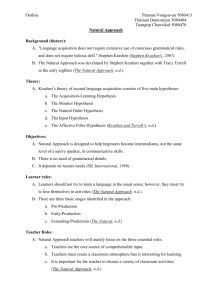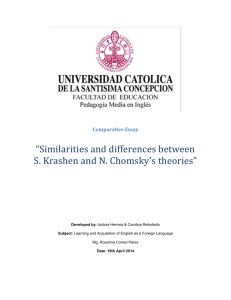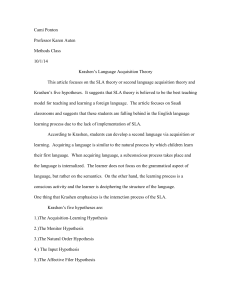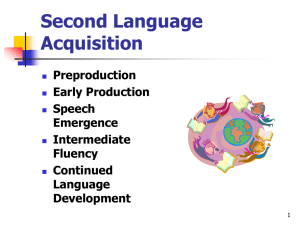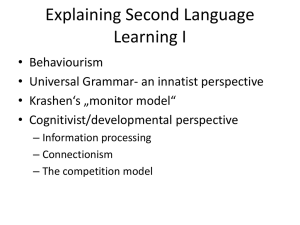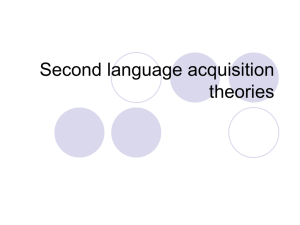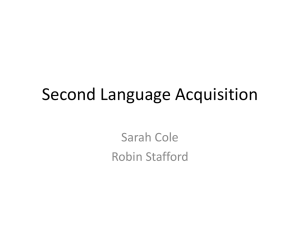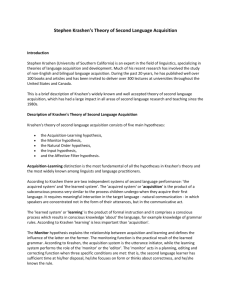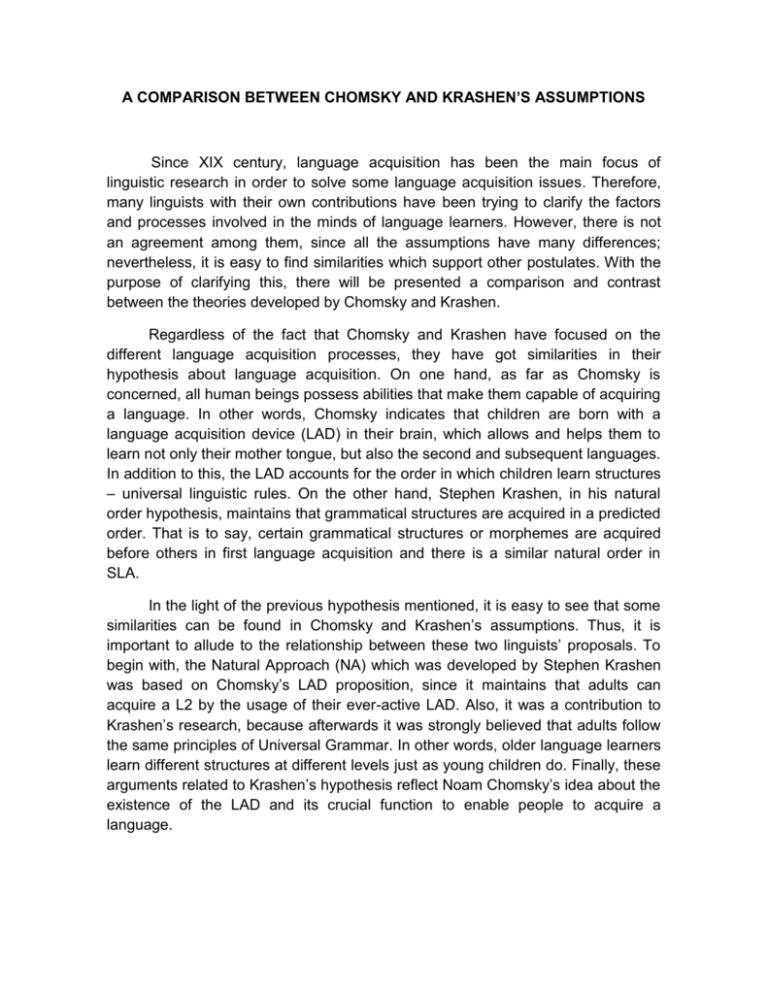
A COMPARISON BETWEEN CHOMSKY AND KRASHEN’S ASSUMPTIONS
Since XIX century, language acquisition has been the main focus of
linguistic research in order to solve some language acquisition issues. Therefore,
many linguists with their own contributions have been trying to clarify the factors
and processes involved in the minds of language learners. However, there is not
an agreement among them, since all the assumptions have many differences;
nevertheless, it is easy to find similarities which support other postulates. With the
purpose of clarifying this, there will be presented a comparison and contrast
between the theories developed by Chomsky and Krashen.
Regardless of the fact that Chomsky and Krashen have focused on the
different language acquisition processes, they have got similarities in their
hypothesis about language acquisition. On one hand, as far as Chomsky is
concerned, all human beings possess abilities that make them capable of acquiring
a language. In other words, Chomsky indicates that children are born with a
language acquisition device (LAD) in their brain, which allows and helps them to
learn not only their mother tongue, but also the second and subsequent languages.
In addition to this, the LAD accounts for the order in which children learn structures
– universal linguistic rules. On the other hand, Stephen Krashen, in his natural
order hypothesis, maintains that grammatical structures are acquired in a predicted
order. That is to say, certain grammatical structures or morphemes are acquired
before others in first language acquisition and there is a similar natural order in
SLA.
In the light of the previous hypothesis mentioned, it is easy to see that some
similarities can be found in Chomsky and Krashen’s assumptions. Thus, it is
important to allude to the relationship between these two linguists’ proposals. To
begin with, the Natural Approach (NA) which was developed by Stephen Krashen
was based on Chomsky’s LAD proposition, since it maintains that adults can
acquire a L2 by the usage of their ever-active LAD. Also, it was a contribution to
Krashen’s research, because afterwards it was strongly believed that adults follow
the same principles of Universal Grammar. In other words, older language learners
learn different structures at different levels just as young children do. Finally, these
arguments related to Krashen’s hypothesis reflect Noam Chomsky’s idea about the
existence of the LAD and its crucial function to enable people to acquire a
language.
One massive difference that must be pointed out between first and second
language acquisition is the existence of an “Affective Filter”. Krashen (1985)
illustrates, five linked hypotheses involved in the L2 processing model being one of
them the affective filter hypothesis. Following this hypothesis, there are several
psychological variables implied in the language acquisition process. That is to say,
emotions play a crucial part in the acquisition process by creating a firewall in the
learner’s mind that can intrude in the way of acquisition by not allowing the learner
comprehend the structures of the target language or new words. Furthermore,
Krashen and Terrell (1983) explicit that factors as motivations (the own student’s
motivation and the one received from his/her environment), self-image, selfconfidence, and the anxiety levels which the student creates while being in direct
contact with the language are the components of this effective filter. Pursuing this
further, several educational models have been created in order to lower the anxiety
levels of the students, and to make the teaching and learning process successful.
Opposite to the previous hypothesis, in first language acquisition there is not
an element such as a filter at the time of acquiring the language. To add, the
critical period is characterized by being situated at the beginning of the
development process in the baby’s mind. Therefore, the awareness in the learner
is not going to be as developed as in an adult to understand and to feel nervous
about using a language. Moreover, with the lack of awareness the learner will not
be conscious about the mistakes that he/she could make. However, this might be
one of the main advantages of L1 among L2 acquisition since there will be no
existing firewall to block acquisition or to make it difficult.
As a conclusion, it is important to recall that there are many different
theories regarding language acquisition, and they all possess different aspects
which can be either similar or opposite. Therefore, it is relevant to add that FLA
and SLA research are not the same; nevertheless, linguists borrow some
techniques and hypothesis that were used in other proposals before in order to
make better and more meaningful contributions for this type of research. Finally,
language acquisition research has made many significant contributions to
education. The Affective Filter hypothesis, for example, is still used by means of
constructing new methodologies for the teaching and learning of the second
language so as to facilitate learning.
REFERENCES
Brown, D. (2006). Principles of Language Learning and Teaching (5th ed.).
New York, NY: Pearson/Longman.
Cook, V. (2001). Second Language Learning and Language Teaching. London:
Hodder Arnold.
Krashen, S. (1985). The Input Hypothesis: Issues and Implications. New York:
Longman.
Krashen, S. & T.D. Terrell. (1983). The Natural Approach: Language Acquisition
in the Classroom. Oxford: Pergamon Press.
Lightbown, P. M. & Spada, N. (1999). How Languages Are Learned. Oxford:
Oxford University Press.

